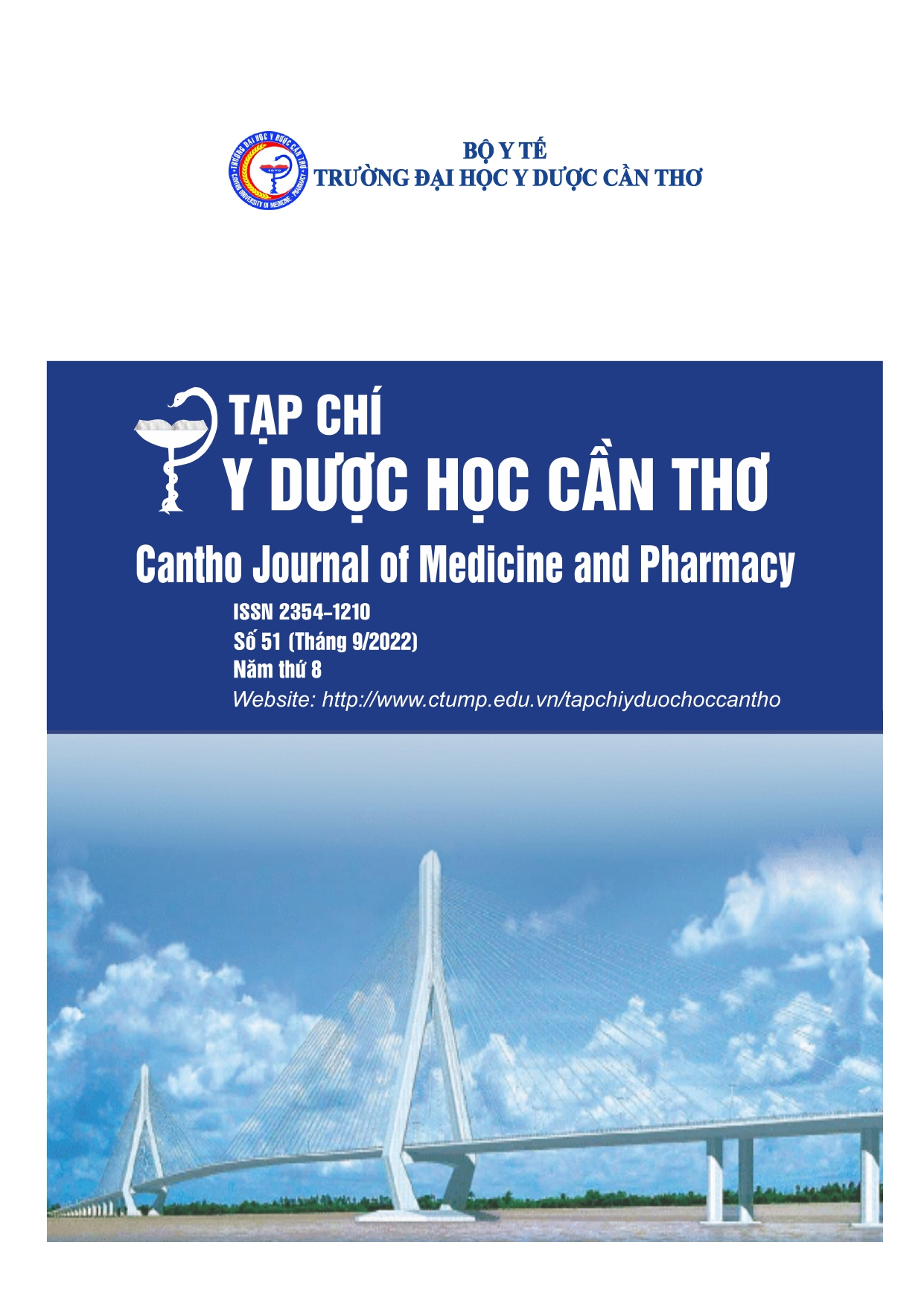NGHIÊN CỨU ĐẶC ĐIỂM THĂM DÒ ĐIỆN SINH LÝ TIM VÀ KẾT QUẢ ĐIỀU TRỊ BẰNG SÓNG CAO TẦN QUA CATHETER Ở BỆNH NHÂN NHỊP NHANH KỊCH PHÁT TRÊN THẤT PHỤ THUỘC NÚT NHĨ-THẤT TẠI BỆNH VIỆN TIM MẠCH AN GIANG NĂM 2021-2022
Nội dung chính của bài viết
Tóm tắt
Đặt vấn đề: Thăm dò điện sinh lý tim là phương pháp chính xác nhất để chẩn đoán, cắt đốt bằng sóng cao tần qua catheter thích hợp điều trị triệt để cho hầu hết bệnh nhân. Mục tiêu nghiên cứu: Nghiên cứu đặc điểm điện sinh lý tim và kết quả điều trị bằng sóng cao tần ở bệnh nhân nhịp nhanh kịch phát trên thất (PSVT) phụ thuộc nút nhĩ-thất. Đối tượng và phương pháp nghiên cứu: Nghiên cứu cắt ngang mô tả, được tiến hành trên 57 bệnh nhân có điện tâm đồ bề mặt là PSVT phụ thuộc nút nhĩ-thất đến khám và điều trị tại Bệnh viện Tim mạch An Giang từ 01/2021-05/2022. Tất cả bệnh nhân được thăm dò điện sinh lý tim và điều trị cắt đốt bằng sóng cao tần. Các bệnh nhân được theo dõi 1 tháng sau xuất viện về triệu chứng lâm sàng và tái phát. Kết quả: Trong nghiên cứu của chúng tôi, độ tuổi trung bình là 48,95±13,88 (15-73). Nữ chiếm đa số với 38 bệnh nhân (66,7%) và nam là 19 bệnh nhân (33,3%). Tần suất nhịp nhanh vào lại nút nhĩ-thất là 38 (64,41%) và nhịp nhanh vào lại nhĩ-thất là 21 (35,59%). Tỷ lệ thành công của thủ thuật là 100%. Trong nghiên cứu, có 3 bệnh nhân (5,26%) có biến chứng nhẹ là tụ máu vị trí chọc mạch và block nhĩ thất có hồi phục. Không có biến chứng nặng và tử vong. Chỉ có duy nhất 1 bệnh nhân (1,75%) tái phát sau cắt đốt. Kết luận: Kết quả nghiên cứu của chúng tôi cho thấy thăm dò điện sinh lý tim là phương pháp chẩn đoán chính xác các dạng PSVT phụ thuộc nút nhĩ-thất. Điều trị bằng sóng cao tần qua catheter có kết quả thành công cao, tỷ lệ biến chứng thấp và nhẹ. Tỷ lệ tái phát rất thấp.
Chi tiết bài viết
Từ khóa
Thăm dò điện sinh lý tim, catheter, nút nhĩ-thất
Tài liệu tham khảo
2. Tôn Thất Minh (2016), “Điều trị nhịp nhanh kịch phát trên thất QRS hẹp do vòng vào lại nút nhĩ thất hoặc vòng vào lại nhĩ thất bằng năng lượng sóng có tần số radio qua catheter”, Tạp chí Y Học TP. Hồ Chí Minh, Tập 20 (1), tr. 238-244.
3. Tôn Thất Minh (2016), “Đặc điểm lâm sàng và điện sinh lý nhịp nhanh kịch phát trên thất QRS hẹp do vòng vào lại nút nhĩ thất hoặc vòng vào lại nhĩ thất”, Tạp chí Y Học TP. Hồ Chí Minh, Tập 20 (1), tr. 230-237.
4. Phạm Trường Sơn (2017), “Nghiên cứu hiệu quả triệt đốt bằng sóng tần số radio của nhịp nhanh kịch phát trên thất vòng vào lại nút nhĩ thất”, Tạp chí Y – Dược Quân Sự, (6), tr. 91-98.
5. Nguyễn Công Vân (2015), “Hiệu quả ban đầu và trung hạn của thủ thuật cắt đốt đường chậm ở bệnh nhân nhịp nhanh do vòng vào lại nút nhĩ thất”, Tạp chí Y Học TP. Hồ Chí Minh, Tập 19 (5), tr. 54-58.
6. Phạm Nguyễn Vinh (2008), Bệnh học tim mạch- tập I, Nhà xuất bản y học, Thành phố Hồ Chí Minh.
7. Phạm Nguyễn Vinh (2008), Bệnh học tim mạch- tập II, Nhà xuất bản y học, Thành phố Hồ Chí Minh.
8. Brugada J., et al. (2020), “2019 ESC Guidelines for the management of patients with supraventricular tachycardia”, European Heart Journal, Vol 41, pp.655-720.
9. Canpolat U., et al. (2020), “State of Fluoroless Procedures in Cardiac Electrophysiology Practice”, J Innov Cardiac Rhythm Manage, Vol 11(3), pp.4018-4029.
10. Feldman A., et al. (2011), “Predictors of Acute and Long-Term Success of Slow Pathway Ablation for Atrioventricular Nodal Reentrant Tachycardia: A Single Center Series of 1,419 Consecutive Patients”, PACE, Vol 34, pp.927-933.
11. Issa Z. F., Miller J. M., Zipes D. P. (2019), Clinical Arrhythmology and Electrophysiolog: A companion to Braunwald’s Heart Disease, Elsevier, Philadelphia, pp.560-728.
12. Jackman W. M., et al. (1991), “Catheter ablation of accesssory pathways (Woff-Parkinson-White syndrome) by radiofrequency current”, N Engl J Med, Vol 324, pp.1605-1611.
13. Kuck KH, et al. (1991), “Radiofrequency current catheter ablation of accesssory atrioventricular pathways”, The Lancet, Vol 337, pp.1557-1561.
14. Zipes D. P, Peter L., Bonow R. O., Mann D. L., Tomaselli G. F. (2018), Braunwald’s Heart Disease: A Textbook of Cardiovascular Medicine, Eleventh Edition, Elsevier Inc, Canada, pp.597-729.


